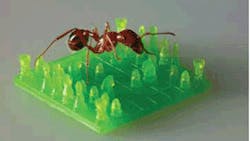Prototyping holds promise at Pacific Design
When it comes to advanced design software, CAD programs such as ProEngineer, Inventor, SolidWorks, CATIA, Solid Edge, and others are the gold standard. Many of these programs will be on display with their latest iterations at Pacific Design and Manufacturing, taking place February 14 to 16 in Anaheim, Calif.
However, when it comes to the hold standard — actual physical models you can hold in your hand — rapid prototyping (RP) tools take center stage by turning CAD data into physical prototypes. Also called additive manufacturing, tools such as 3D printers and stereolithography machines create highly detailed parts one layer at a time using a variety of techniques. Several companies offering different approaches to RP will be on display at Pacific Design. One of these companies, FineLine Prototyping Inc., Raleigh, N.C., offers this overview of today's additive manufacturing technologies:
Though stereolithography is the oldest of all RP technologies, it remains state-of-the-art for overall accuracy, surface finish, and resolution. It uses an ultraviolet laser focused to a small point, drawing on the surface of a liquid thermoset resin. Where it draws, the liquid turns solid. This is repeated in thin 2D cross-sections that are layered to form complex 3D parts. Material properties are typically inferior to those of selective laser sintering, but the surface finish and detail are unmatched.
Selective laser sintering (SLS) uses a CO2 laser that draws onto a hot bed of thermoplastic powder. Where it draws, it lightly sinters the powder into a solid. After each layer, a roller deposits a fresh layer of powder on top of the bed and the process repeats. Because SLS uses engineering thermoplastics, its parts exhibit greater toughness than other methods. The chief benefits of SLS include strength, toughness, and durability.
3D printing has become a catchall name in recent times, but it is reserved primarily for technologies that make 3D parts using office-friendly machines that don't require extensive operator training. Many machines use inkjet technology in some way to deposit material in 2D layers that build up to 3D. Strengths include speed, cost-effectiveness, and high resolution.
Many other additive manufacturing technologies also exist. Fused Deposition Modeling (FDM) by Stratasys and Perfactory by EnvisionTEC are two examples that thrive as viable tools for both prototyping and rapid manufacturing. Others occupy small niches in the marketplace or have fallen by the wayside. For more information, visit finelineprotyping.com and canontradeshows.com/expo/pdm12.
